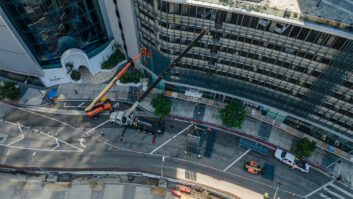Sony Professional Displays & Solutions has announced that its BRAVIA professional displays form an integral part of the European Space Agency (ESA)’s FLEXHab space, which will provide training and information for astronauts and scientists ahead of outer-space missions. The FLEXHab space is located inside a dedicated facility at the European Astronaut Centre, in Cologne, Germany.
Built by architect specialists SAGA, the 28sqm lunar habitat will simulate life on the Moon’s surface for astronauts to perform scientific research. It utilises Sony BRAVIA professional displays to replicate the Moon’s environment.
 The ESA unveiled FLEXHab on Wednesday 25 September and its first official astronaut training mission will begin in March 2025. The facility has been in construction since June and will continue to undergo rigorous tests.
The ESA unveiled FLEXHab on Wednesday 25 September and its first official astronaut training mission will begin in March 2025. The facility has been in construction since June and will continue to undergo rigorous tests.
The 65in Sony BRAVIA displays have been integrated to replicate a large artificial window – the ‘viewing dome’ – that will make up one wall to completely immerse inhabitants during training.
The displays will be integral to preparing inhabitants to deal with any eventuality when residing in space, including the possibility of outer-space catastrophes. BRAVIA displays will be used to simulate scenarios such as large debris colliding with the window, causing a crack or pressure leak.
The displays will also add an element of interactivity to the training, enabling astronauts to perform simulated external experiments from inside FLEXHab using specialist tools and BRAVIA displays for real-time visual guidance.
The habitat houses up to four astronauts on training missions anywhere from one week to month-long periods, meaning the space has to be both liveable and serve its scientific purpose. Its multi-functionality includes communal areas, bedrooms, workout equipment and a laboratory.
Sebastian Aristotelis, CEO at SAGA, said: “It’s been over 50 years since humans last landed on the Moon, and now, the world is preparing for astronauts to land on the Moon again safely and efficiently. For the most part, astronauts are inside the habitat conducting research during their time in outer-space, so testing astronauts in FLEXHab’s environment is critical to the success of future missions.”
He continued: “Being able to simulate external events, environments and experiments visually using Sony BRAVIA means that we can make training as accurate as possible and deliver the best possible preparation for astronauts ahead of space travel. The displays aren’t just static to emulate the Moon’s surface, they are integral to testing the astronauts. With Sony BRAVIA, any environment can be loaded in minutes, so there’s massive potential for additional uses.”
Aristotelis says existing space habitats for training on earth focus on preparing astronauts to be able to live in small spaces for long periods, or sometimes require huge physical facilities to be transformed into a simulated lunar surface using terrestrial rocks. But FLEXHab is different, he argues, because it integrates exterior environments and tests how they impact the interior environment.
He comments: “Partnering with Sony to integrate its BRAVIA displays has allowed us to do this. The displays deliver exceptional picture quality, allowing astronauts to train with near-perfect accuracy, and to see and feel connected to the outside world, which is hugely important for mental well-being.”
Matthias Maurer, ESA astronaut and project lead, added: “I am absolutely thrilled to see and check-out our new FLEXHab LUNA module. It is a centrepiece of our new LUNA Moon analogue facility, completing the Moon surface inside the LUNA hall with the intravehicular side of a Moon lander or Moon base. FLEXHab will enable ESA and DLR to run complex and fully end-to-end integrated multi-day missions.”
Petra Norinder, junior trade marketing manager North region at Sony Professional Displays and Solutions, concluded: “Sony BRAVIA’s extra wide-viewing angles and anti-reflective Deep Black Non-Glare technology mean that it maintains its high contrast colours and exceptional picture quality no matter where it’s viewed in the room. This makes it the perfect display to help completely immerse inhabitants within their training environments.”







